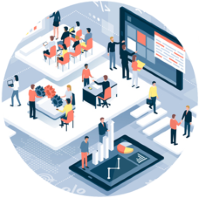What are digital platforms?
A digital platform should handle end-to-end clinical and business processes necessary to achieve an optimised experience for citizens/patients, employees, and partners.
Digital platforms may cut across traditional organisational structures, silos, policies, and technology investments. They promote transformation of organisation structures, mindsets, policies and processes.
what 'digital' is...
User-first Culture - to be digital, the culture within an organisation must be to deliver user needs; capabilities that are beneficial to the user with quick results and cost-effective. It is also critically important to ensure that both patients, citizens and the workforce have the necessary digital skills to benefit from new transformation initiatives.
Accessible - digital capabilities should not alienate or exclude any user groups based on their skills or abilities. Systems should provide alternatives to conventional visual interfaces to support visually impaired users and content should be designed and authored appropriately to be accessible to a range of cognitive abilities.
Instant Feedback - users to expect instant feedback to their requests. They should not have to wait minutes, hours or days to know that their request has been successful or not. When considering target response times, these should be measured in milliseconds.
Real-time - a digital system should expect to receive requests 24 hours a day, every day and be available on demand. The data used and returned by the system should be the latest whenever possible.
Automated - a digital service should include as much automated computer processing as possible (ideally 100%), without the need for manual intervention.
Intelligent - digital services should do all the heavy lifting, minimising the effort and understanding required by users or other machines. An intelligent service means it should be able to handle raw information from the user, transform it and perform necessary calculations without them ever being aware. Intelligence means the service should be able to anticipate a user’s next steps to prepare and suggest actions.
Online - a digital system should be accessible anywhere with an Internet connection, with no unreasonable limitations on devices or usage.
Beautiful - beautiful UIs and well-designed APIs. This is best practice for a service in the digital age. It should be easy to use and develop against; intuitive and meet the needs of target users in order to promote widespread adoption.
Promote change - a digital service defines business processes, and is not defined by them. Digital means business processes changing as part of the transformation. Don’t mimic offline processes in an online way.
Regular Improvements - a digital platform should be improved and upgraded as often as necessary.
What 'digital' is not...
Just a technology refresh - technology does not make you digital. Being in the cloud is not digital. Developing a microservices architecture is not digital. Using NoSQL is not digital. If you see an organisation describing its digital transformation programme by highlighting its technology achievements, it can probably be surmised that they’re not doing digital transformation right.
Batch - offline feeds and scheduled processing should not be relied on to manage information. Machine to machine communication should be via APIs and sent and retrieved as soon as information is available. This ensures information is as up-to-date as possible.
Manual - digital processes should avoid manual intervention or processing by default. Any offline intervention should be seen as exceptions for those that are not willing or able to use digital services, or where machine learning/processing is not yet mature enough.
